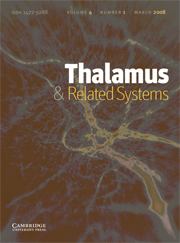Crossref Citations
This article has been cited by the following publications. This list is generated based on data provided by
Crossref.
Bazhenov, Maxim
Timofeev, Igor
Fröhlich, Flavio
and
Sejnowski, Terrence J.
2008.
Cellular and network mechanisms of electrographic seizures.
Drug Discovery Today: Disease Models,
Vol. 5,
Issue. 1,
p.
45.
Fröhlich, Flavio
Sejnowski, Terrence J.
and
Bazhenov, Maxim
2010.
Network Bistability Mediates Spontaneous Transitions between Normal and Pathological Brain States.
The Journal of Neuroscience,
Vol. 30,
Issue. 32,
p.
10734.
Kramer, Mark A.
Truccolo, Wilson
Eden, Uri T.
Lepage, Kyle Q.
Hochberg, Leigh R.
Eskandar, Emad N.
Madsen, Joseph R.
Lee, Jong W.
Maheshwari, Atul
Halgren, Eric
Chu, Catherine J.
and
Cash, Sydney S.
2012.
Human seizures self-terminate across spatial scales via a critical transition.
Proceedings of the National Academy of Sciences,
Vol. 109,
Issue. 51,
p.
21116.
Stamoulis, Catherine
Schomer, Donald L.
and
Chang, Bernard S.
2013.
Information theoretic measures of network coordination in high-frequency scalp EEG reveal dynamic patterns associated with seizure termination.
Epilepsy Research,
Vol. 105,
Issue. 3,
p.
299.
Bernard, Christophe
Naze, Sebastien
Proix, Timothée
and
Jirsa, Viktor K.
2014.
Modern Concepts of Focal Epileptic Networks.
Vol. 114,
Issue. ,
p.
121.
González, Oscar C.
Krishnan, Giri P.
Chauvette, Sylvain
Timofeev, Igor
Sejnowski, Terrence
and
Bazhenov, Maxim
2015.
Modeling of Age-Dependent Epileptogenesis by Differential Homeostatic Synaptic Scaling.
The Journal of Neuroscience,
Vol. 35,
Issue. 39,
p.
13448.
Chauvette, Sylvain
Soltani, Sara
Seigneur, Josée
and
Timofeev, Igor
2016.
In vivo models of cortical acquired epilepsy.
Journal of Neuroscience Methods,
Vol. 260,
Issue. ,
p.
185.
Doyon, Nicolas
Prescott, Steven A.
and
De Koninck, Yves
2016.
Mild KCC2 Hypofunction Causes Inconspicuous Chloride Dysregulation that Degrades Neural Coding.
Frontiers in Cellular Neuroscience,
Vol. 9,
Issue. ,
Fröhlich, Flavio
2016.
Network Neuroscience.
p.
297.
Proix, Timothée
Bartolomei, Fabrice
Guye, Maxime
and
Jirsa, Viktor K.
2017.
Individual brain structure and modelling predict seizure propagation.
Brain,
Vol. 140,
Issue. 3,
p.
641.
Salami, Pariya
Borzello, Mia
Kramer, Mark A.
Westover, M. Brandon
and
Cash, Sydney S.
2022.
Quantifying seizure termination patterns reveals limited pathways to seizure end.
Neurobiology of Disease,
Vol. 165,
Issue. ,
p.
105645.
Agarwal, Shubham
Basu, Ishita
Kumar, Manish
Salami, Pariya
and
Cash, Sydney S
2022.
Classification of Seizure Termination Patterns using Deep Learning on intracranial EEG.
p.
2933.
Currin, Christopher Brian
and
Beyer, Chad
2023.
Encyclopedia of Child and Adolescent Health.
p.
86.


